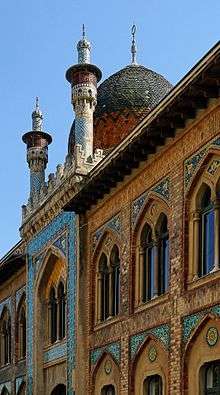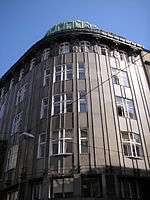Johann Zacherl
Johann Zacherl (1814 – 30 June 1888) was an Austrian inventor, industrialist and manufacturer who made a fortune in the late 19th century selling dried flower heads of Chrysanthemum cinerariifolium as an insecticide.
Johann Zacherl | |
|---|---|
| Born | 1814 |
| Died | June 30, 1888 |
| Occupation | inventor, businessman |
| Known for | Zacherlin (insecticide) |


Biography
Zacherl was born in Munich (Germany) in 1814. After finishing his studies, he left Munich to visit Vienna, St Petersburg and Odessa. He eventually reached Tiflis in the Caucasus, where he discovered villagers used a natural insecticide, Pyrethrum, against vermin. He began to develop the powder's trade with Austria in 1842. The powder received different names: Lowizachek (in Armenia), Bug Flower, Powder of Persia and Persian insect powder.[1]
After a longer stay in Tiflis, in 1855 he established his company, Mottenfraß-Versicherungsunternehmung Johann Zacherl, in Vienna's 19th district, and began selling the insect repellent Zacherlin. With the help of his son, Johann Evangelist, he developed the Pyrethrum product line.
Zacherlin insecticide

Zacherl developed an effective, all-natural moth insecticide made from Pyrethrum blossoms. He agreed with the chiefs of the villages to collect the flowers and ship them to Tiflis. He then ground the dried blossoms into powder, filled bags with it, and put them in sheep leathers for transport to Europe.[2] He continued importing dried heads of Chrysanthenum Cinerariifolum and Chrysanthenum Coccineum directly from Tifflis until 1870, when he began producing it locally.[3] His insecticide powder was called Zacherlin. He developed other products, including a carpet-cleaning machine "distributing over the cleansed carpet the insecticide to guard it against the attack of moth" in 1882,[4] a Pyrethrum Soap,[5] and a tincture for destroying insects.[6]
According to Hiscox, the insecticide was obtained as follows:[7]
The powder is obtained by brushing the dried flowers of the pellitory (pyrethrum). The leaves, too, are often used. (...) The active principle is not a volatile oil, as stated by some writers, but a rosin, which can be dissolved out from the dry flowers by means of ether. The leaves also contain this rosin but in. smaller proportions than the flowers. Tincture of pyrethrum is made by infusing the dried flowers in five times their weight of rectified spirit of wine. Diluted with water it is used as a lotion. (...) The dust resulting from the use of insect powder sometimes proves irritating to the mucous membranes of the one applying the powder. This is best avoided by the use of a spray atomizer.
Zacherlin's packaging showed a cossak with a high cap and an atomizer in hand, a marketing strategy that proved very successful.
According to Brigitte Hamann,[8] Dr Karl Lueger, a mayor of Vienna known for his public antisemitic statements,[9] "once joked in a public meeting at Zacherlin squirts (Zacherlinspritzen in German) that one would have to invent against the Jews (Zacherlin was considered a powerful insect extermination mean)".[10] Forty years later, the Nazis used another insecticide, Zyklon B, on civilians, including many Jews, in the gas chambers of Auschwitz and Majdanek during the Holocaust.
Architecture
The insecticide factory in Döbling was designed by the architect Hugo von Wiedenfeld and constructed by Karl Mayreder in 1888–1892. Explicitly oriental in style, the polychromed brick building with pointed arches, two minarets and a dome was one of Vienna's most recognized structures.
Since the collapse of the Zacherl company, the building has been used as a warehouse for carpets, furs and textiles. Today, it is used for art exhibitions and symposiums, in association with the contemporary art exhibitions Position:Gegenwart at Jesuit's Church of Vienna.[2][11]

Zacherl's son, Johann Evangelist Zacherl, commissioned Jože Plečnik to build the office building Zacherlhaus in Vienna's Innere Stadt from 1903–1905.[12] It includes a row of atlantes along the cornice line by sculptor Franz Metzner.
References
- American Institute of the City of New York (1860). Annual Report of the American Institute of the City of New York for the years 1859–60. C. van Benthuysen. p. 152. Retrieved 22 November 2007.
(...) The insect destroyer has proved of great utility. (...) The powder was tried and proved to be not dangerous to human beings while it destroyed insects. It is now stated to be a species of Chamomile, the Pyrethrum roseum of Biebers and the Pyrethrum carneum, also. The powder of these obtained the name of Lowizachek in Armenia – of Bug Flower Powder of Persia. (...)
- Schörghofer, Gustav (2 June 2007). "Zacherlfabrik 2007" (in German). Österreichische Provinz der Gesellschaft Jesu. Retrieved 15 November 2007.
- Sotriffer, Kristian (1996). Die Blute Der Chrysantheme. Die Zacherl, Stationen einer anderen Wiener Burgerfamilie (in German). Köln: Böhlau. ISBN 978-3-205-98503-7.
- US patent 262530, Johann Zacherl, "Carpet-cleaning machine", issued 1882-08-08
- US patent 308172, Johann Zacherl, "Pyrethrum Soap", issued 1884-11-18
- Woodcroft, Bennet (1865). Chronological index of patents applied for and patents granted For the Year 1864. Holborn: Office of the commissioners of patents for inventions. p. 18.
(...) N°226: Johann Zacherl of Vienna and of 3 Bury Court in the City of London for an invention for an improved tincture or liquid preparation for destroying insects (27 January 1864) (...)
- Hiscox, Gardner Dexter (1916). Henley's Twentieth Century Forrmulas, Recipes and Processes, containing ten thousand selected household and workshop formulas, recipes, processes and moneymaking methods for the practical use of manufacturers, mechanics, housekeepers and home workers. 2. New-York: Norman W. Henley. pp. 424. Retrieved 22 November 2007.
- Hamann, Brigitte (2000). Hitler's Vienna. Oxford Oxfordshire: Oxford University Press. ISBN 0-19-514053-2.
- Lueger was known for his antisemitism since 1887. Decades later, Austrian-born Adolf Hitler saw him as an inspiration for his own virulent hatred of anything Jewish and paid him an enthusiastic tribute in Mein Kampf. (see wikipedia article on Karl Lueger)
- Götz, Thomas (10 May 1996). "Beim Wiener Bürgermeister in die Lehre gegangen" (in German). Berliner Zeitung. p. 53. Archived from the original on 30 September 2008. Retrieved 19 October 2007.
- "Position:Gegenwart" (in German). Österreichische Provinz der Gesellschaft Jesu. 2 June 2007. Archived from the original on 2 June 2008. Retrieved 15 November 2007.
- Podbrecky, Inge (2004). Viennese Jugenstil (Ed. 1 ed.). Falter. p. 112. ISBN 3-85439-339-3.